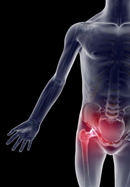The hip is a ball-and-socket joint, surrounded by large muscles. The ball, the round head of the femur (thigh bone), is set deeply in the acetabulum, a deep socket or cavity in the pelvis. The joint is very stable. The majority of long-term hip problems are associated with aging, disease (such as arthritis) and fractures. But pain in the hip and thigh also can be caused by injury to muscles, tendons or bursas, usually from a fall, a blow or overuse.
 Hip pain in athletes involves a wide differential diagnosis. Adolescents and young adults are at particular risk for various apophyseal and epiphyseal injuries due to lack of ossification of these cartilaginous growth plates. Older athletes are more likely to present with tendinitis in these areas because their growth plates have closed. Several bursae in the hip area are prone to inflammation. The trochanteric bursa is the most commonly injured, and the lesion is easily identified by palpation of the area.
Hip pain in athletes involves a wide differential diagnosis. Adolescents and young adults are at particular risk for various apophyseal and epiphyseal injuries due to lack of ossification of these cartilaginous growth plates. Older athletes are more likely to present with tendinitis in these areas because their growth plates have closed. Several bursae in the hip area are prone to inflammation. The trochanteric bursa is the most commonly injured, and the lesion is easily identified by palpation of the area.
Quadricep, hamstring, and Iliotibial band injuries can be quite painful. However, there are several ways to help stabilise muscular pulls. Compression braces can help provide stabilization to the torn muscle fibers and improve the ability to walk or help protect from further injury. Ice packs and cold wraps help reduce pain and inflammation, and pain relief gels can provide temporary relief of painful symptoms. Many athletes use magnetic products to stimulate blood flow and reduce pain.
One of the biggest causes of hip and back pain is the psoas muscle. These problems include but are not limited to lower backpain, sciatica, disc problems, knee pain, pelvic tilting, digestive problems, infertility, and menstruation pain. You could also experience scoliosis, a difference in the length of your legs, kyphosis, sacroiliac pain and accentuated lumbar lordosis.
Bursitis in the hip usually involves the hip socket and causes tenderness, pain, and swelling on the outer part of the hip where some of the large buttock muscles attach. Bursitis in the hip can cause pain that spreads to the buttocks and down as far as the knee. Bursitis in the hip can be caused by activities such as speed-walking, aerobic dance, or carrying a baby on your hip. It also can be caused by conditions that alter the normal tilt of the pelvis, such as having one leg shorter than the other.
As the pain improves, gradually begin to exercise. It is best to work with a physical therapist to learn proper exercises and how to advance your activity. Swimming may be a good option because it stretches the muscles and builds good muscle tone without straining your hip joint. However, swimming does not build bone mass. When you are ready (a physical therapist can help determine that), slowly and carefully resume walking or another activity against the resistance of gravity.
A hip fracture can change the quality of your life significantly. Fewer than 50% of those with a hip fracture return to their former level of activity. In addition, while recovering from a hip fracture, several possible complications can be life-threatening. These include pneumonia and a blood clot in the leg, which can dislodge and travel to cause a clot in the lungs. Both are due to immobility following a hip fracture and hip surgery.
A groin pull can be caused by a quick change in direction while you’re moving—often occurring in sports such as hockey, tennis, and basketball. A groin pull can result in pain, tenderness, and stiffness deep in the groin, making activity difficult.










Join the Discussion
Type out your comment here:
You must be logged in to post a comment.